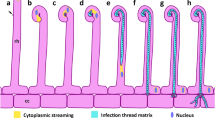Abstract
Staining of infected legume roots with 0.01% methylene blue facilitated the observation of the initial steps of the Rhizobium—legume symbiosis. It allowed particularly the visualization by bright-field microscopy of infection threads in the root hairs and the root cortex of the host plant.
Similar content being viewed by others
References
Bishop, P.E., Guevarra, J.G., Engelke, J.A., Evans, H.J. (1976) Relation between glutamine synthetase and nitrogenase activity in the symbiotic association between Rhizobium japonicum and Glycine max. Plant Physiol. 57, 542–546
Brill, W.J. (1981) Agricultural microbiology. Sci. Am. 245, 146–156
Callaham, D.A., Torrey, J.G. (1981) The structural basis for infection of root hairs of Trifolium repens by Rhizobium. Can. J. Bot. 59, 1647–1664
Dazzo, F.B. (1982) Leguminous root nodules. In: Experimental microbial ecology, pp. 431–446, Burns, R.G., Slater, I.H., eds. Blackwell, Oxford London Boston
Dazzo, F.B., Hubbell, D.H. (1982) Control of root hair infection. In: Ecology of nitrogen fixation, vol. 2: Rhizobium, pp. 274–310, Broughton, W.J., ed. Oxford University Press, Oxford
Fåhraeus, G. (1957) The infection of clover root hairs by nodule bacteria studied by a simple glass slide technique. J. Gen. Microbiol. 16, 374–381
Libbenga, K.R., Harkes, P.A.A. (1973) Initial proliferation of cortical cells in the formation of root nodules in Pisum sativum L. Planta 114, 17–28
Phillips, D.A. (1971) Abscisic acid inhibition of root nodule initiation in Pisum sativum. Planta 100, 181–190
Pueppke, S.G. (1983) Rhizobium infection threads in root hairs of Glycine max (L) Merr., Glycine soja Sieb. and Zucc., and Vigna unguiculata (L.) Walp. Can. J. Microbiol. 29, 69–76
Rolfe, B.G., Gresshoff, P.M., Shine, J. (1980) Rapid screening for symbiotic mutants of Rhizobium and white clover. Plant Sci. Lett. 19, 277–284
Truchet, G., Rosenberg, C., Vasse, J., Julliot, J.S., Camut, S., Dénarié, J. (1984) Transfer of Rhizobium meliloti p Sym genes into Agrobacterium tumefaciens: host specific nodulation by atypical infection. J. Bacteriol. 157, 134–142
Turgeon, B.G., Bauer, W.D. (1982) Early events in the infection of soybean by Rhizobium japonicum. Time course and cytology of the initial infection process. Can. J. Bot. 60, 152–161
Vincent, J.M. (1980) Factors controlling the Legume-Rhizobium symbiosis. In: Nitrogen fixation, vol. 2, pp. 103–129, Newton, W.E., Orme-Johnson, W.H., eds. University Park Press, Baltimore, Md.
Author information
Authors and Affiliations
Rights and permissions
About this article
Cite this article
Vasse, J.M., Truchet, G.L. The Rhizobium — legume symbiosis: observation of root infection by bright-field microscopy after staining with methylene blue. Planta 161, 487–489 (1984). https://doi.org/10.1007/BF00407080
Received:
Accepted:
Issue Date:
DOI: https://doi.org/10.1007/BF00407080




